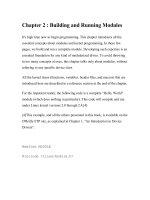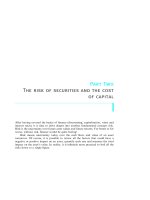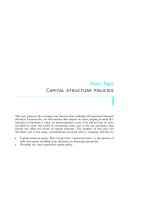Chapter 2: Internal Control Deficiencies _part1 ppt
Bạn đang xem bản rút gọn của tài liệu. Xem và tải ngay bản đầy đủ của tài liệu tại đây (96.01 KB, 10 trang )
13
Chapter 2: Internal Control Deficiencies
Given that the department is responsible for the majority of the State’s
employees and that the average amount of loss expense is $7.6 million
over the last two years, it is irresponsible to not have clear guidance.
While the duties of initial reserve setting and claims processing have
evolved over time, management opts to not formalize this in fear of
potential liability. No clear review process exists, and often claims
processing is subjective. This has led to errors in processing that could
otherwise have been prevented. Moreover, in much the same way that
accurate financial reporting is not a priority, accuracy in claims
processing data is also lacking.
The Employee Claims Division within the department is responsible for
planning and administering the State’s Workers’ Compensation Program
for 18 executive branch agencies and the Legislature. The only entities
specifically excluded are the Department of Education and the University
of Hawai‘i. Additionally, the department administers the claims for the
Department of Transportation and the Stadium Authority but does not
receive appropriations for, and is not responsible to pay, related benefits.
The department’s responsibilities include the administering of funds
appropriated for the purpose of paying workers’ compensation benefits
for employees in general funded and certain federally funded positions.
During FY2006, 560 new workers’ compensation claims were opened,
which are part of the $6.6 million in claims and benefits expenditures.
At June 30, 2006, there were approximately 1,680 total active claims
being administered by the department.
The department’s responsibilities for workers’ compensation are not
limited to the processing of claims and making related payments.
Equally important is estimating all future payments that will need to be
made on individual cases and establishing reserves for the total liability.
These reserves must be periodically reviewed and updated because, as
claim information changes, the estimated future liability changes.
At the end of each reporting period, another reserve is necessary to
capture the possibility of future claims. Incurred But Not Reported
(IBNR) reserves represent estimated liabilities for employees who were
injured during the reporting period but who do not file the related claims
with their respective departments until after the end of the period. As
provided in Section 386-82, Hawai‘i Revised Statutes (HRS), an
employee is entitled to compensation within two years after the date at
which the effects of the injury for which the employee is entitled to
compensation have become manifest, and within five years after the date
of the accident or occurrence which caused the injury. Therefore, it is
common for employees to sustain injuries during a fiscal year and report
them to their department long after the fiscal year ends, thus requiring a
reserve liability. Governmental Accounting Standards Board Statement
The State’s workers’
compensation
responsibilities include
establishing and
updating reserves
This is trial version
www.adultpdf.com
14
Chapter 2: Internal Control Deficiencies
No. 10, Accounting and Financial Reporting for Risk Financing and
Related Insurance Issues, paragraph 22, instructs that a “liability for
unpaid claims costs, including estimates of costs related to incurred but
not reported claims, should be accrued when insured events occur.”
A systematic process for establishing, reviewing, and updating reserves
is critical in ensuring accurate workers’ compensation reserves, including
IBNR. In addition to satisfying accounting and reporting requirements,
accurate workers’ compensation reserves allow the State to plan for this
significant liability and ensure funds will be available to meet these legal
obligations as they become due.
Ultimately, the department does not think it is important to track over
$29 million related to workers’ compensation claims that it, and the
State, will be liable for paying. The department does not feel it is
responsible for calculating or reporting the total reserves on claims it is
responsible for, including IBNR, on an ongoing basis, as these amounts
are reported in the statewide Comprehensive Annual Financial Report
(CAFR). While it is true that workers’ compensation reserves are
reported in the State’s CAFR, we believe that this does not absolve the
department of its responsibility to report the reserves as well as to
maintain accurate records.
Workers’ compensation data is maintained in the Human Resource
Management System but the department does not track or report the total
related reserves. The department did generate a workers’ compensation
reserve report as of June 30, 2006, which was then recorded by the CPA
firm it hired to compile its financial statements. However, the reserve
report was generated only in anticipation of our audit, and the
department-hired CPA firm found that the reserve report understated the
related expense and liability by approximately $672,000. Further, based
on our audit work, we found additional, significant errors with the
reserve report, as delineated in Exhibit 2.2 and explained further below.
We emphasize that the misstatements discovered during our audit and
presented below are based on testing of only a sample of the total claims,
and that the total actual misstatement could be much larger if the entire
population was reviewed or if known errors were extrapolated over the
entire population.
The department does
not recognize its
$29 million workers’
compensation liability
This is trial version
www.adultpdf.com
15
Chapter 2: Internal Control Deficiencies
The department is responsible for providing centralized management of
workers’ compensation claims for most of the State’s employees,
including administering the funds appropriated for the purpose of paying
workers’ compensation benefits. As the responsibility for the processing
and administering of funds is held within the department, the department
should also report the liability for the Workers’ Compensation Program,
including IBNR.
Workers’ compensation claims reserve records are inaccurate
Reporting responsibilities aside, the department should maintain accurate
workers’ compensation records so that the amount of the liability
reported is proper. Currently, DAGS calculates the workers’
compensation reserve related to claims handled by the department, which
is subsequently audited and reported in the State’s Comprehensive
Annual Financial Report (CAFR). However, this calculation is based on
historical payroll and insurance data and does not rely on claims specific
Exhibit 2.2
Workers’ Compensation Expense and Reserve as of, and for the Year Ending June 30, 2006
Workers’ Workers’ Incurred
Comp Comp But Not
Expense Reserve Reported
Reported by DHRD (per CPA-prepared
trial balance) $6,550,000 $0 $0
Adjustments posted by another CPA firm:
Per Workers’ Compensation Reserve run report 0 28,553,000 0
Additional adjustments 672,000 672,000 0
Unaudited balances (per CPA prepared trial balance) 7,222,000 29,225,000 0
Misstatements found by our audit:
Changes made to claims reserve balance after
year-end but not properly recorded (1,567,000) (439,000) 0
Reserves closed after year-end but not updated
to reflect actual payments (278,000) (364,000) 0
Payments per claims detail did not agree to
actual payments made (372,000) (372,000) 0
Unrecorded IBNR (528,000) 0 1,201,000
Total misstatements (2,745,000) (1,175,000) 1,201,000
Corrected balance, for known misstatements $4,477,000 $28,050,000 $1,201,000
Source: Compiled by Accuity LLP
This is trial version
www.adultpdf.com
16
Chapter 2: Internal Control Deficiencies
data. While this approach may satisfy applicable accounting and
auditing standards, it confirms our finding that the department does not
maintain accurate workers’ compensation claims records.
As noted in the most recent State of Hawai‘i Report on Internal Control
over Financial Reporting and on Other Matters as of June 30, 2005
(issued in conjunction with the CAFR audit), “the claims reserves report
accumulated [by the Department of Human Resources Development] in
the current year continues to be inaccurate and unreliable for purposes of
determining the State’s estimated workers’ compensation liability.” The
internal control report further recommends that the department “should
maintain adequate documentation in claims files to support its estimates
of future expected costs for all open claims (case reserves)” and “should
perform an actuarial analysis of the required reserve estimate using
generally accepted actuarial techniques.”
Impact of unrecorded IBNR is not understood
In addition to the responsibilities of maintaining accurate records, the
department must understand the importance of recognizing these
liabilities as soon as it can be reasonably estimated. Recording the IBNR
is an integral responsibility when administering workers’ compensation
since it recognizes the potential that a claim may come in years after an
incident occurs and provides a mechanism for the department to meet
GASB standards requiring the recordation of the impact.
The department currently records the workers’ compensation claims and
benefits expenditures as the claims are paid, identifying them with the
related cash flows. IBNR claims represent additional expenses related to
workers’ compensation claims that the department is liable for as of the
fiscal year end but unaware of until subsequent to that fiscal year end.
Since IBNR requires analysis of potential claims and workers’
compensation claims are tracked based on the cash flows, IBNR had
never been recorded. Therefore, recording the IBNR reserve based on a
historical loss analysis and future projections will allow the department
and the State to adequately budget and plan for these future obligations.
Staff are not equipped to calculate a reasonable IBNR reserve
The department’s staff neither understands the need to record IBNR, nor
are they well equipped to perform these calculations. The calculation of
IBNR reserves is complex, relying on a combination of assumptions and
estimates, which can be subjective, and case file information provided by
the department. Due to the complexity of the task of calculating the
IBNR reserve, the calculation is usually performed by a loss reserve
specialist using various statistical models.
This is trial version
www.adultpdf.com
17
Chapter 2: Internal Control Deficiencies
Currently the department does not have staff qualified to perform these
calculations, nor is a specialist contracted to perform this analysis. As
noted by the American Institute of Certified Public Accountant’s Audit
Guide, Audit of Property and Liability Insurance Companies,
Chapter 4.70, “the absence of involvement by a loss reserve specialist in
the determination of management’s estimate may constitute a reportable
condition and possibly a material weakness in the entity’s internal
control.” However, until the department can resolve its problems with
accurate recording and reporting of its financial and workers’
compensation information, using a loss reserve specialist would be
ineffective.
We estimated the IBNR reserve based on a ten year historical loss
analysis using workers’ compensation payment reports generated by the
department. As Section 386-82, HRS, provides for a five year time
frame after the date of injury for liability purposes, we calculated the
average percentage of claims paid within five years. Using these
percentages and actual claims payments, we estimated the amount of
claims to be reported in the years subsequent to June 30, 2006 for
injuries occurring as of June 30, 2006, shown as Exhibit 2.3.
Exhibit 2.3
Workers’ Compensation Claims – Incurred But Not Reported
Reserves
Year of Claims Paid as of Incurred But Not
Injury June 30, 2006 Reported Reserves
2002 $12,451,000 $21,000
2003 6,731,000 11,000
2004 8,476,000 28,000
2005 6,588,000 191,000
2006 4,962,000 950,000
Total $1,201,000
Source: Compiled by Accuity LLP using claims paid data from reports generated from the
department’s Human Resource Management System
Based on a lack of understanding of the importance of recording IBNR,
the staff’s inability to calculate IBNR, and inaccurate or incomplete data
to rely on, the department does not calculate or record an IBNR reserve.
This is trial version
www.adultpdf.com
18
Chapter 2: Internal Control Deficiencies
The department has no formal policies and procedures with respect to
either the workers’ compensation reserve or the IBNR. The process of
initial creation and subsequent closure of reserves has evolved over time,
with certain key individuals driving the function. The department elects
not to adopt formal policies over the processing of workers’
compensation claims; however, this has led to errors and significant
misstatements of related balances.
The workers’ compensation claims process is informal
No formal policies exist over the approval of workers’ compensation
claims, establishment of reserves, processing of payments, and reporting
and reviewing claims activity. For example, when claims are first
received by the department, the personnel program manager establishes
the initial reserve. However, the reserve calculation is not based on any
established or documented criteria, as the personnel program manager
relies on her 30 plus years of experience. Additionally, there is no
systematic process for reviewing and updating the reserve to coincide
with and reflect significant activity, such as when claim payments are
made. The entire Workers’ Compensation Program is governed by
informal procedures that have evolved over time to meet the
department’s needs. These informal procedures do include checks to
ensure that incoming claims are accompanied with appropriate forms and
that claim payments are proper. However, if these procedures are not
documented there is no assurance that they are consistently applied,
greatly increasing the likelihood of errors. Moreover, the turnover or
extended absences of key personnel could compromise the continuity of
the entire program.
Lack of rules intended to avoid potential liability
Surprisingly, the department claims it was advised by the Department of
the Attorney General not to have formal, written policies regarding
workers’ compensation claims that could subject the department or State
to potential administrative proceedings if it failed to comply with such
policies. However, the department was unable to provide any record or
documentation of this guidance received from the Department of the
Attorney General.
In addition to not establishing procedures over the Workers’
Compensation Program, the department does not concern itself with
accurate reporting of claims activity. The department feels that its
primary concern is to pay the claims timely, while the reporting of
workers’ compensation reserves is not a priority. However, as stewards
of the Workers’ Compensation Program, claims data, and allocated
funds, the department needs to take ownership of the entire process,
especially considering the magnitude of dollars.
Unclear
responsibilities,
polices, and
procedures contribute
to errors
This is trial version
www.adultpdf.com
19
Chapter 2: Internal Control Deficiencies
A lack of written policies feeds into the department’s current practice of
reporting and recording workers’ compensation data when convenient to
its employees’ schedules. In effect, this leads to large misstatements
which affect the workers’ compensation reserve balance. Misstatements
noted in our current audit arose from adjustments to claims balances after
year-end that were not properly recorded; claim reserves closed
subsequent to year-end but not updated to reflect actual, final payments;
case reserves details excluding previous payments; and under-reserving
or over-reserving on claims due to simple typographical errors with no
oversight.
Lax policies result in significant errors and misstatements
Gross misstatements to the department’s workers’ compensation expense
and liability accounts are the result of no formal policies, as the
department failed to identify and record certain adjustments to the
reserve liability and related expense account in the proper fiscal year end.
Due to the nature and significance of the department’s workers’
compensation reserve balance, we tested a sample of 225 and 176 claims
reserve balances at June 30, 2006 and 2005, respectively. We obtained
the claim files and compared the payments to supporting documentation,
noting several errors that resulted in various misstatements to the reserve
balances.
We noted deficiencies in the department’s process to ensure the State’s
workers’ compensation liability was properly analyzed and reported for
the year ended June 30, 2006. Many of the misstatements could have
been avoided if clear guidance had been available to employees.
Misstatements were caused by time lags between posting of payments
and when payments were made. Duplication of payments occurred and
was not readily identified by the department. Previous payments made
by other state departments were not properly communicated to prevent
duplication at a later date. In addition, no process is in place for the
calculation and recording of IBNR.
For example, changes or adjustments to the claims balances after the
year-end were not properly recorded by the department, which resulted
in the reserve balance being overstated by approximately $439,000 at
June 30, 2006 and understated by approximately $1.1 million at June 30,
2005. Losses should be reflected in the year the injury occurred or based
on other known factors, and the reserve balance should be adjusted for
changes to the estimates. According to GASB Statement No. 10,
paragraph 22, “A liability for unpaid claims costs, including estimates of
costs relating to incurred but not reported claims, should be accrued
when insured events occur . . . that liability should be based on the
estimated ultimate cost of settling the claims (including the effects of
This is trial version
www.adultpdf.com
20
Chapter 2: Internal Control Deficiencies
inflation and other societal and economic factors), using past experience
adjusted for current trends, and any other factors that would modify past
experience.”
In addition, we identified 60 workers’ compensation claim reserves that
were closed subsequent to year-end, but the actual claim reserves were
not updated to reflect the final payments, resulting in an overstatement of
the reserve balance of $242,032. Additional procedures performed on
reserves not selected for testing increased the overstatement to
approximately $364,000 and $86,000 at June 30, 2006 and 2005,
respectively. Based only on our sample testing, we noted an
overstatement of reserves, as shown by type in Exhibit 2.4.
Exhibit 2.4
Overstatement of Reserve Type
Reserve Type Instances Overstated
Permanent partial disability 10 $106,680
Medical expense 20 98,083
Administrative expense 20 25,177
Temporary total disability 6 7,025
Temporary partial disability 2 4,642
Disfigurement 2 425
Total 60 $242,032
Source: Compiled by Accuity LLP’s testing from Department of Human Resources
Development summary warrant vouchers
The department generally reviews claims files on a quarterly basis and
will “zero out” any remaining reserve balance for closed claims.
However, the department had not performed the quarterly review from
June 30, 2006 through our testing date of October 23, 2006, and
therefore the above errors related to closed claims were not identified by
the department.
Further, the amount reflected as paid according to the workers’
compensation reserve detail as of June 30, 2006 did not agree with the
actual payments for the following reserves, resulting in the net
overstatement reflected in Exhibit 2.5.
This is trial version
www.adultpdf.com
21
Chapter 2: Internal Control Deficiencies
Exhibit 2.5
Claims Misstatements
Claim Number Reserve Type Misstatement
19710013 Permanent total disability $(1,074)
29840831 Permanent total disability (1,089)
20241027 Temporary total disability (1,046)
20440208 Temporary total disability (869)
20540216 Temporary total disability (150)
28941329 Temporary total disability (652)
29740281 Temporary total disability (1,074)
29840831 Temporary total disability 69,685
20440611 Administrative expense (8)
29840831 Administrative expense 234
20441065 Medical (117)
70210162 Medical (619)
Total, Net $63,221
Source: Compiled by Accuity LLP’s testing according to the Department of Human
Resources Development’s reserve detail report and summary warrant vouchers
The errors noted above could have been avoided had there been a clear
written policy detailing employees’ responsibilities with respect to
recording workers’ compensation transactions. A time lag exists
between the date the payments are posted to the workers’ compensation
reserve report by the department and the date the payments are actually
made by DAGS, resulting in an understatement of the reserve balance.
The department recorded the payment when authorized, as of June 30,
2006, but the payment was not processed until after June 30, 2006. We
identified five case reserves with a net understatement of approximately
$1,800.
Additionally, the amount identified as paid on the workers’ compensation
reserve detail improperly included duplicate amounts that were not paid.
Corrections were made after June 30, 2006, rather than as of June 30,
2006. We identified five case reserves with a net understatement of
approximately $4,900. Amounts identified as paid on the workers’
compensation reserve detail improperly excluded previous payments
made by the respective state departments prior to the department
processing the workers’ compensation claims. We identified two case
reserves with a net overstatement of approximately $69,900.
We also noted that one claim reviewed was over-reserved by $339,000
and another claim was under-reserved by $30 due to key stroke inputting
errors by the department personnel at June 30, 2006. Additional errors
This is trial version
www.adultpdf.com
22
Chapter 2: Internal Control Deficiencies
may exist, but they would likely not be discovered without an adequate
review of the workers’ compensation reserve listing by appropriate
department personnel.
These errors and misstatements further underscore the department’s lack
of understanding of the importance of accurate reporting and record
maintenance. As the workers’ compensation liability is the most
significant account balance for the department, it is essential that the
reserve balance be accurately reported in the financial statements and
reported to the State. However with no clear guidance it is unrealistic to
expect more than minimal reporting and record maintenance.
Formal, written policies and procedures should be established related to
workers’ compensation claims. The policies should include the
following:
• guidelines for estimating the initial reserves;
• required documentation and level of detail to support the
estimate;
• requirements to update claim information on a periodic basis;
• requirements to review adequacy of reserves on a periodic basis;
• requirements to record claim payments based on actual payments
by DAGS rather than when authorized; and
• requirements to institute a checklist for all claim files to ensure
necessary procedures are performed and documented.
When the policies are established and approved, they should be
distributed, acknowledged, and enforced by those employees involved
with workers’ compensation claims. Additionally, formal training should
be conducted to ensure these policies and procedures are properly
implemented and monitored to ensure the workers’ compensation claims
are properly accounted for.
The department should also consider contracting a loss reserve specialist
to actuarially evaluate and calculate the IBNR reserve due to the
complexity of the analysis. In addition to assumptions and estimates, the
analysis also involves using historical loss data in conjunction with
statistical models to estimate the IBNR reserve. Therefore, it is essential
that the underlying historical loss data maintained by the department be
accurate, as the specialist is not responsible for the accuracy of the data.
Recommendations
This is trial version
www.adultpdf.com









